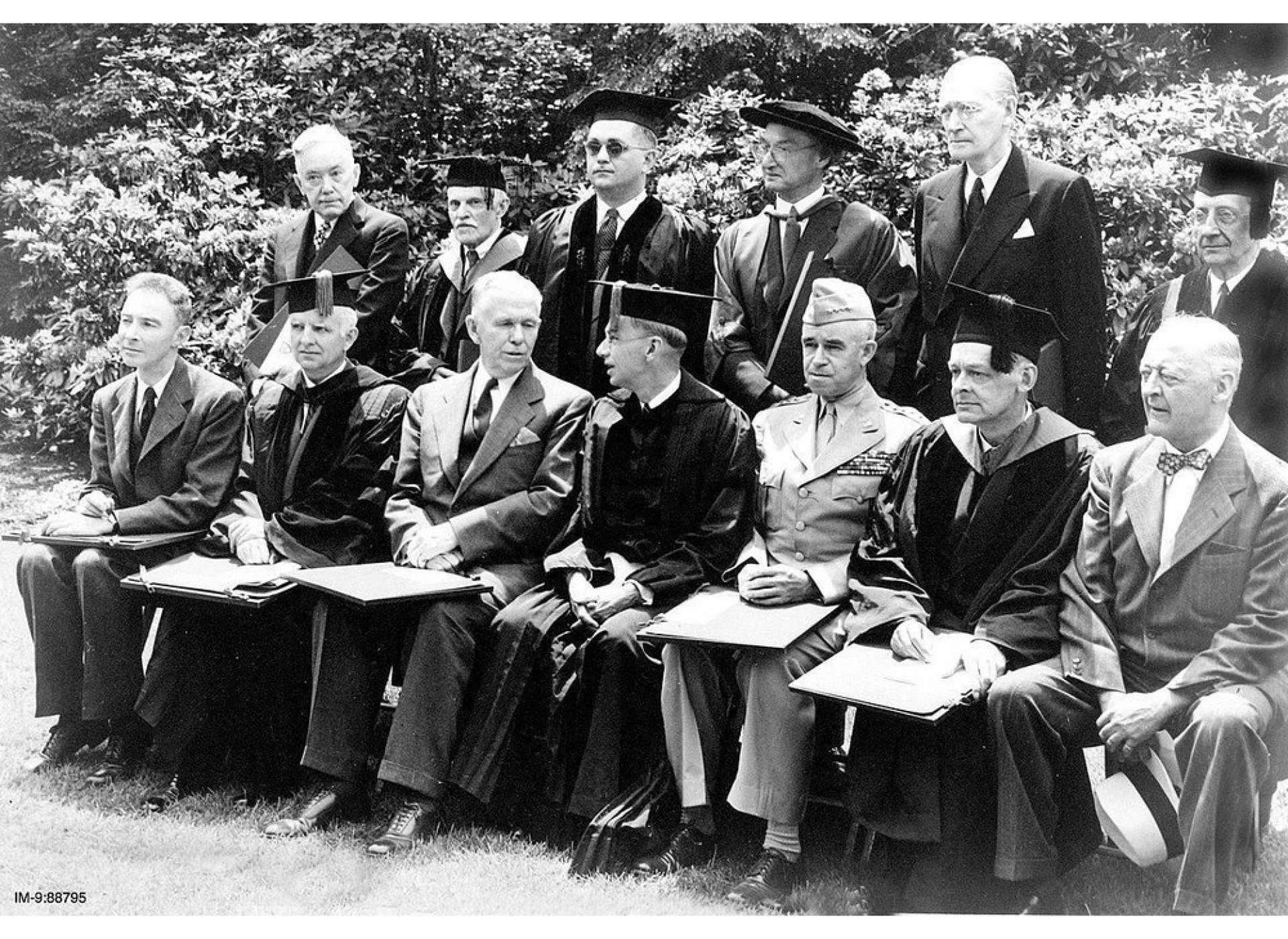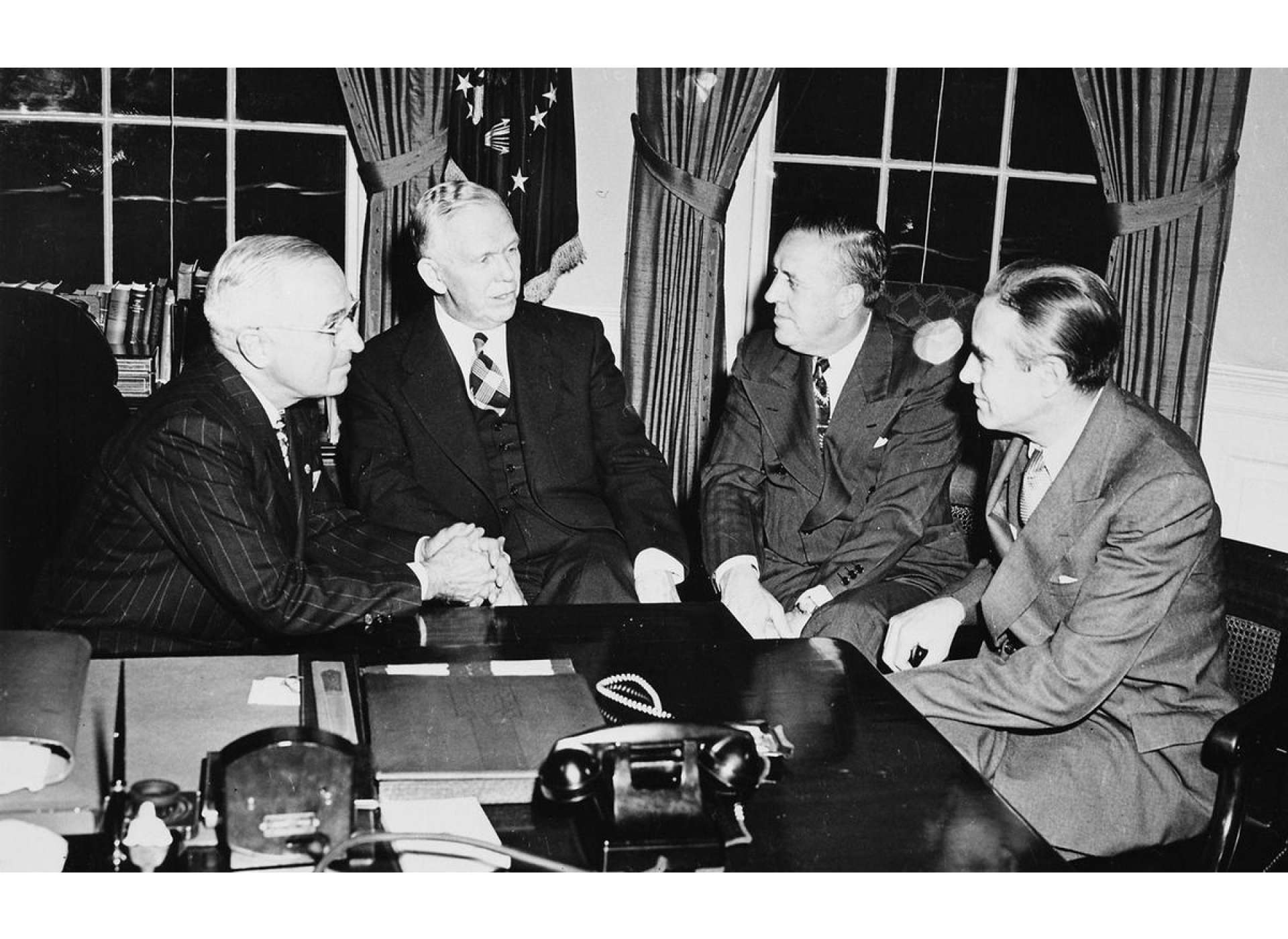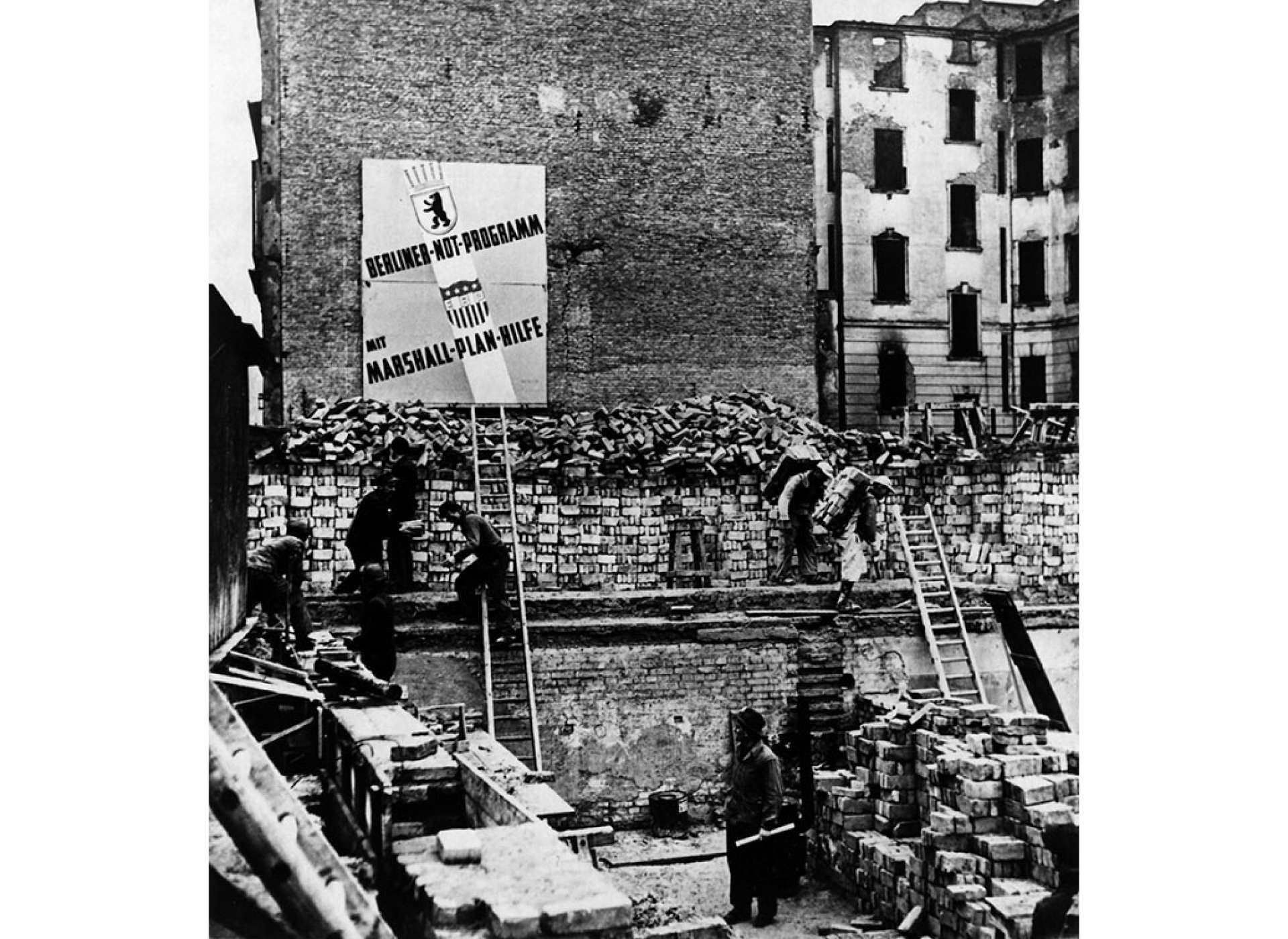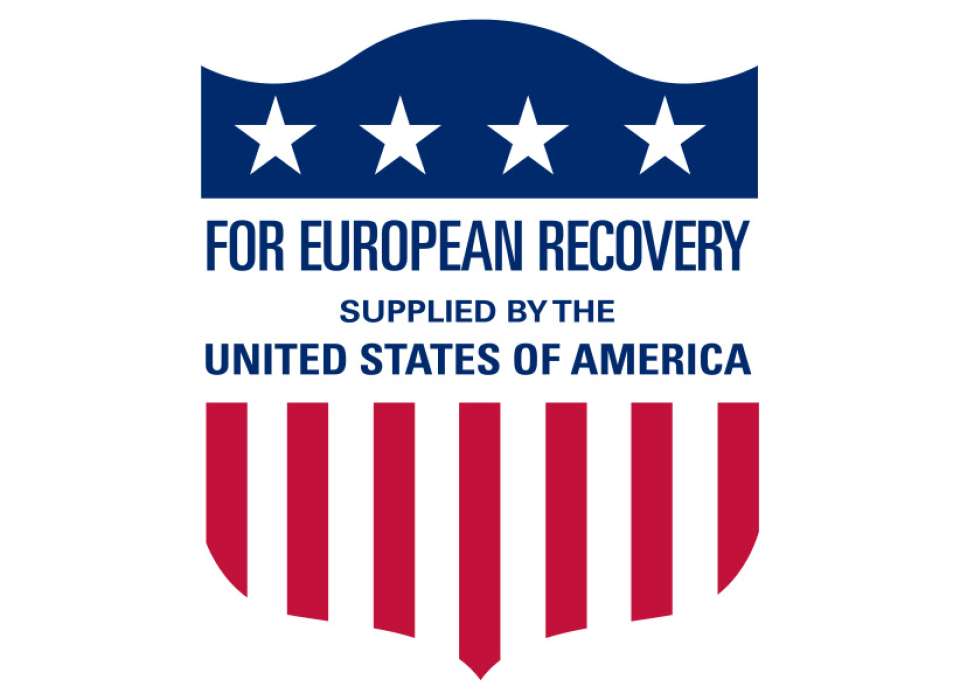Top image:Marshall Plan logo, courtesy of the George Marshall Foundation.
On May 8, 1947, Under Secretary of State Dean Acheson stood before a board of farmers and businessmen gathered in a small town in the middle of the Mississippi Delta, ready to unveil the blueprint for one of the most significant strategic actions of the early Cold War: The Marshall Plan. Acheson traveled to Delta State University in Cleveland, Mississippi to attend the annual meeting of the Delta Council that has drawn representatives every year since 1935 from the far reaches of the Delta region to discuss crops, finances, and social activities.
But the poplin and seersucker-suited men of the Delta Council were about to be treated to a description of an ambitious economic plan designed to assist Europeans with economic recovery following the devastation of World War II. During his speech, Acheson stressed that “the ultimate recovery of Europe and Asia depended on the reconstruction of Germany and Japan,” the “great workshops” of their respective continents, that would require international aid to restore prewar levels of economic stability.
Acheson stressed, however, that this form of “emergency aid” would not just be for the rebuilding of Germany and Japan–soon to be US allies in a new Cold War order dominated by the United States and Soviet Union–but for “building world political and economic stability, in promoting human freedom and Democratic institutions, in fostering liberal trading policies, and in strengthening the authority of the United States.” And he needed the support of all Americans, including the local farmers and businessmen of the Mississippi Delta, to strengthen America’s role in securing peace and prosperity in an increasingly insecure world.
The following month during a commencement speech delivered to the graduating class of Harvard University, then Secretary of State and former Army Chief of Staff George Marshall revealed a rough outline of Acheson’s Delta Council proposition. Marshall alluded to the need for the United States to create a program for European economic recovery “so far as it may be practical for us to do so” and to make it a joint effort between the United States and European nations. There was little denial amongst Marshall or other American leaders that Europe was struggling to rebuild and the economic situation abroad was deteriorating.
While industrial output was rebounding to prewar levels (particularly in western Germany), this did not transfer into rapid economic growth for Europe, as most of the recovery came from borrowing against stocks and foreign assets, and trade consisted mainly of importing food for hungry people. There was also a growing dollar deficit in Europe, something that Acheson explained to the Delta Council was also negatively influencing the American economy: without enough dollars to pay for imports, European nations would be prohibited from trading with the United States, creating financial difficulties for farmers and businessmen.

George C. Marshall (third from left, front row) receiving an honorary degree at Harvard University, June 5, 1947, courtesy of the George C. Marshall Center for Security Studies.
The economic threat was also an indicator of brewing strategic troubles for the United States. During the early years of the Cold War, the fear that economic struggles could lead to political instability and open the door for communist and Soviet influences in Europe characterized a new approach to foreign affairs. Tensions between the United States and the Soviet Union over postwar geopolitical influence in Europe signaled a growing conflict between the two superpowers.
American leaders, particularly Acheson, diplomat and director of policy planning for the State Department George Kennan, Marshall, and President Harry Truman feared that parties and organizations backed by the Soviet Union could ascend to power in the vulnerable European nations. This would allow the Soviets to establish a foothold that would spell trouble for American economic and political interests in an increasingly polarizing Europe.
Truman and his advisors pointed to instability in Greece and Turkey following the war as proof of a need for American intervention. Civil War in Greece between the communist-backed National Liberation Front and the British-supported Greek monarchy challenged Britain’s already strained ability to support anti-communist forces while trying to rebuild after the war.
Soviet pressure on Turkey to grant the USSR special privileges for using the Turkish Straits for trade also strained Britain’s ability to militarily bolster Turkey. The British formally requested that the United States take over supporting Turkey and Greece in February 1947, prompting Truman to call for a plan of economic and military aid to “support free peoples who are resisting attempted subjugation by armed minorities or by outside pressures.” This became known as the Truman Doctrine.
In response, Congress approved $400 million in aid to Greece and Turkey with broad support from the American public, followed by success in pushing back the communist forces in Greece. But the Truman Doctrine provided strong rhetoric for continuously assisting in the fight against communism rather than a policy that set clear guidelines for what came next. From July 1945 through December of 1947, the $400 million dedicated to supporting anti-communist forces under the Truman Doctrine was part of approximately $11 billion in aid to Europe, much of which was intended for more immediate humanitarian relief from social, economic, and political challenges to Europe, rather than longterm plans for stability.
As economic conditions in Europe continued to stagnate while the fear of communist political infiltration increased, many in Truman’s administration recognized a need for a more structured plan that would directly address the underlying condition–economic instability. Ideally, a more comprehensive plan would also call for joint cooperation between the United States and European nations in solving economic challenges rather than simply an injection of aid by the United States. These ideas would form the basis of the European Recovery Program (ERP), or the Marshall Plan.
While Marshall is the man associated with the ERP as a result of his Harvard commencement speech, historians have noted that many in Truman’s administration contributed to the plan’s overall objectives. Marshall and Kennan criticized Truman’s reliance on superficial rhetoric rather than clear, extended economic plans for European recovery, which prompted both to investigate what the best forms of aid would be.
Acheson also recognized a need for a more comprehensive and detailed recovery plan and, as a result, charged Kennan with preparing a report early in 1947 that clearly outlined the difficulties with trade, imports, and recovery in Europe. But later in his memoirs, Acheson explained that it was Truman’s Under Secretary of State for Economic Affairs, William Clayton, who had the most influence on the final iteration of the Marshall Plan.
Born in Tupelo, Mississippi, Clayton was a partner in a successful cotton firm based in Oklahoma before entering a life of civil service. During World War I, he served on the Cotton Distribution Committee of the War Industries Board and continued to advise Presidents Roosevelt and Truman on economic matters during the war before obtaining his position as Under Secretary, which he held from 1946 through 1947. In this role, he traveled to Europe during the postwar period and witnessed first hand the continent’s struggles to overcome wartime devastation and economic instability.
As a businessman, Clayton was concerned about trade relations between the United States and European nations, but also warned of the political dangers and threats from communism that could be found in the ruins of World War II. In March of 1947, Clayton wrote a memo to Truman expressing his concern about European economic conditions. He considered Britain’s inability to maintain economic support for Greece and Turkey and urged his colleagues to take seriously his worries about what this meant for the political future of Europe and the world:
“The reins of world leadership are fast slipping from Britain's competent, but now very weak hands. These reins will be picked up either by the United States or by Russia. If by Russia, there will almost certainly be a war in the next decade or so, with the odds against us. If by the United States, war can almost certainly be prevented.”
After attending the United Nations Economic Commission for Europe in Geneva in May 1947, Clayton submitted a report, “The European Crisis,” directly to Marshall. Clayton argued that the economic situation was far worse than anyone could imagine, and that “without further prompt and substantial aid from the United States, economic, social and political disintegration will overwhelm Europe.”
Marshall’s attendance of the Moscow Conference in April 1947 further solidified Clayton’s concerns as well as Marshall’s belief that the Soviet Union could not be entrusted to cooperate with the United States or other European nations in developing an economic recovery plan. The conference called together the “Big Four” (British Foreign Minister Ernest Bevin, Marshall, Soviet Foreign Minister Vyacheslav Molotov, and French Foreign Minister Georges Bidault) to discuss an official peace treaty after the war between the Soviets and Germany and Austria and the reconstruction of Germany. Marshall not only blamed the Soviets for stalling the peace talks, but also recounted later in an interview that it was at that moment that he realized Clayton’s reports rang true:
The Marshall Plan was an outgrowth of the disillusionment over the Moscow Conference which proved conclusively that the Soviet Union was not negotiating in good faith and could not be induced to cooperate in achieving European recovery.
Marshall later used his commencement address at Harvard to introduce a broad proposal–rather than a program–to the attendees and ultimately the public:
“It is logical that the United States should do whatever it is able to do to assist in the return of normal economic health to the world, without which there can be no political stability and no assured peace. Our policy is not directed against any country, but against hunger, poverty, desperation and chaos. Any government that is willing to assist in recovery will find full co-operation on the part of the United States. Its purpose should be the revival of a working economy in the world so as to permit the emergence of political and social conditions in which free institutions can exist.”
Marshall’s speech called on European nations to work with each other and the United States on economic recovery, rather than to simply receive an injection of financial aid to rebuild Europe. In return, it was believed democracy as well as peace and prosperity would flourish worldwide. Marshall did not want to outright exclude the Soviet Union, but wanted to create a spirit of open cooperation for the greater good while also recognizing America’s growing international, anti-communist role in the new Cold War world order.
With the general goals introduced, Marshall and others in Truman’s administration set to work figuring out how this plan would be different from previous forms of postwar aid. The group decided that in order for the plan to be successful, participating European nations must assist in developing the plan for recovery which would, as Marshall indicated, “provide a cure rather than a mere palliative” for economic distress, one that would promote long term economic growth. Also, Marshall and Truman wanted the plan to be approved with bipartisan support from Congress and broad approval from the American public.

From left to right, President Harry S Truman, General George Marshall, Paul Hoffman and Averell Harriman in the Oval Office discussing the Marshall Plan, Nov. 29, 1948, courtesy of the National Archives and Records Administration.
On July 12, 1947, representatives from 16 European nations met in Paris to discuss the economic problems they faced as well as potential solutions–a required form of self-sufficiency for receiving aid under the proposed plan. From this meeting emerged the Committee of European Economic Cooperation (CEEC), a collaborative group of participating members who agreed to create a four-year program that would address challenges in production and economic stability within and across their respective nations. Marshall did not exclude any European nations from joining the group, including the Soviet Union.
The USSR and its satellites, however, rejected the conditions of the plan for fear of limits to their economic sovereignty–further supporting Marshall’s convictions that there was no interest in cooperation among the Soviets and raising concerns about the USSR's motives in Europe and beyond. Once the CEEC presented its self-determined plan to Marshall, Truman and his administration worked closely with Congress, as well as various federal agencies, including the Council of Economic Advisers. The latter produced a study of the impact of exportation demands under the proposed plan on production and supplies.
By early 1948, the Truman Administration had hammered out the multi-stepped Economic Recovery Plan; it now needed to go before Congress. But Truman and his administration also knew that there would be challenges. While Americans overwhelmingly supported the aid under the Truman Doctrine, there was more hesitancy to support nearly $13 billion in taxpayers’ money for an extended, peacetime foreign assistance program, something unprecedented in American history.
With Republicans in charge of Congress, the President and his Democratic supporters faced a challenge in winning approval for the proposed program, particularly during an election year in 1948. Some in Congress argued that rather than combating communism, the Marshall Plan was “a socialist blueprint” itself, threatening to waste money on other nations rather than build up the United States’ own defenses. The cost of supporting Europe would also come at the price of inflation and higher taxes.
Rather than securing economic prosperity for all, Representative Charles W. Vursell argued that the Marshall Plan would “wreck the financial solvency of this Government, engulfing the nation in poverty and chaos.” And the constituents they represented were also not entirely convinced of the need for more European spending. Marshall later recalled that his “greatest fear” in getting this plan passed was the “adverse reaction from the Mid-West[sic]” and its residents who represented the “average” American from the Heartland.
Though Marshall explained that the “selling of the ERP to the American people was an exacting task” and that he “traveled so widely in this regard that it almost seemed as if I were running for office,” by December of 1947, Americans were widely supportive of the plan thanks to public relations undertakings by members of the Administration and various Congressional committee members.
Former Secretary of War Henry Stimson spearheaded the popular Citizens’ Committee for the Marshall Plan, consisting of nearly 300 well-known Americans from industry, politics, and the military who criss-crossed the nation delivering pro-Marshall Plan speeches. The organization circulated petitions and financially supported grassroots women’s groups who drummed up support among suburban housewives for European economic recovery, explaining that it was the best way to promote democracy and keep America and the world safe from economic disruption that could lead to another war.
Acheson’s earlier discussion of an economic recovery plan for Europe during the Delta Council meeting was a harbinger of the type of support that would be required for such a program. Because of Will Clayton’s Mississippi connections and the representative nature of the Council, Acheson recognized that winning the support of America’s businessmen and farmers by arguing that the plan would boost sales through exports and trade was crucial.
But the plan was not without its critics.
Some still clung to the notion that this was an oversized amount of support for unstable nations the United States had just rescued from the clutches of fascism. Others, like former Vice President Henry Wallace, argued that the regimes that would be supported with Marshall Plan funds were rather authoritarian themselves and such a drastic economic action would further polarize the globe.
Nonetheless, thanks to bipartisan support from Congress and cooperation between the Executive and Legislative branches of the government (and a little political pork to persuade representatives and senators with farmers and industrialists as constituents that this would benefit them as well) Congress passed the plan on March 13, 1948, allocating nearly $13 billion in foreign aid over a four-year period.
By the time Marshall Plan aid expired in June of 1952, the program had largely accomplished its goals of creating some economic self-sufficiency among the 16 European nations who participated. The US-managed Economic Cooperation Administration (ECA) and the European-run Organization for European Economic Cooperation (OEEC) oversaw the implementation of the aid allocated under the Marshall Plan.
The OEEC guaranteed that all participating nations upheld their end of the bargain in enacting policies that would boost trade and industrial and agricultural production, while the ECA administered the financial aid for nations to purchase food, fuel, and machinery from the United States and also develop and complete infrastructure programs including highways and railroads. Aid was not always distributed evenly among the nations, and it did not solve all political or economic problems.
Scholars often suggest that the Marshall Plan only further intensified tensions between the United States and the Soviet Union and also point out that five percent of Marshall Plan aid went to the newly-formed Central Intelligence Agency to conduct intelligence collection abroad. Many historians, however, agree that the Plan was successful in restoring agricultural and industrial production and some level of self-sufficiency in European nations as well as preventing the implementation of damaging austerity measures to counteract declining economic conditions.

Rebuilding in Germany, circa 1948. The sign on the wall says “Berlin Emergency Program, with Marshall Plan help," courtesy of the National Archives and Records Administration.
From its first unveiling in Cleveland, Mississippi, to an ambitious program of economic aid to bolster Europe, the Marshall Plan signaled a new era of global responsibility for the United States and a new emerging postwar order.
Stephanie Hinnershitz, PhD
Stephanie Hinnershitz is a historian of twentieth century US history with a focus on the Home Front and civil-military relations during World War II.
Cite this article:
MLA Citation:
APA Citation:
Chicago Style Citation:





![Max Fuchs, New York City cantor, sings as Rabbi Sydney [sic] Lefkowitz, Richmond, VA, conducts the first Jewish services from Germany.](/sites/default/files/styles/max_650x650/public/2025-10/image1.jpg)



